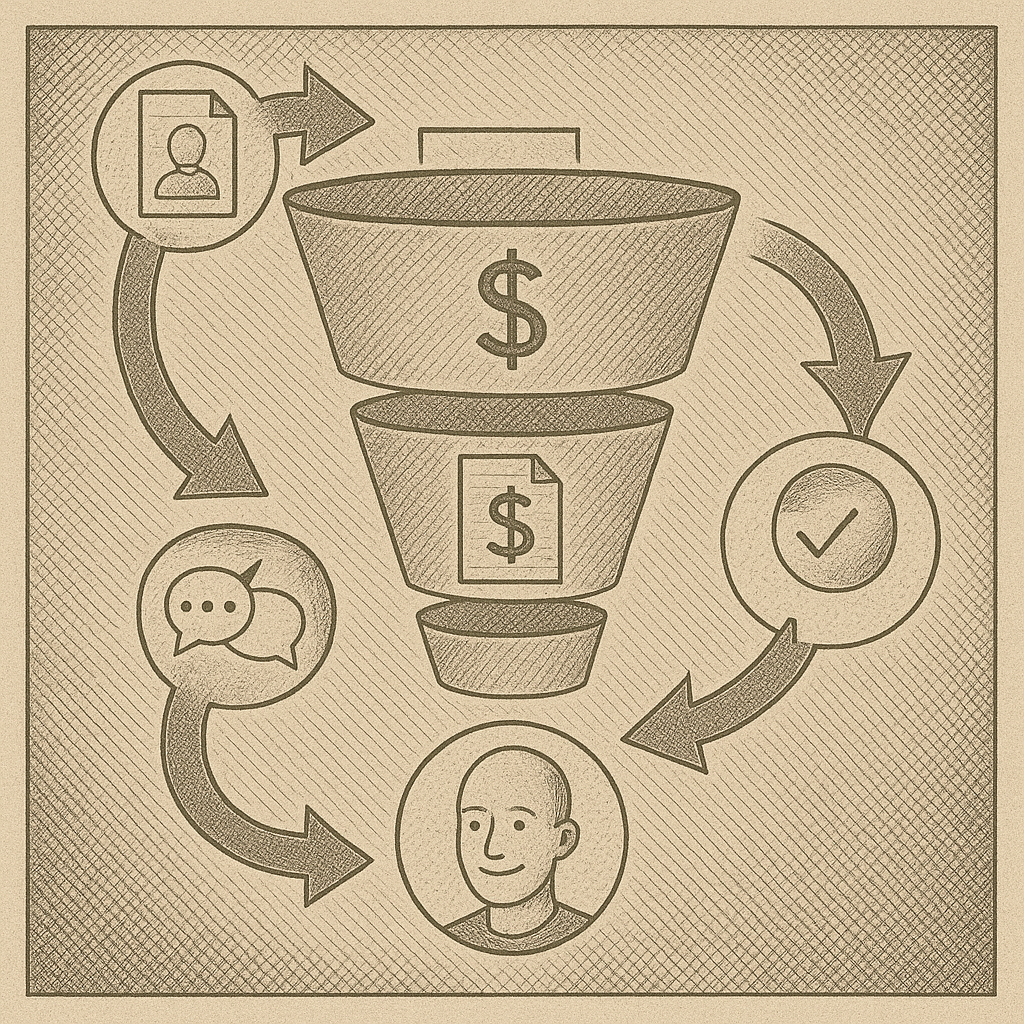
Businesses as Layered Feedback Systems Link to heading
Think of your SaaS business not as a rigid hierarchy, but as a layered system of ongoing conversations and feedback cycles. Every part of the company – product, design, sales, leadership, team culture – performs its own feedback loop, and these loops link together into larger loops. The speed and quality of each loop’s operation determine whether the whole company learns and adapts or stalls out. In fact, shortening the cycle time of ideas and improving feedback quality can dramatically improve a startup’s odds of success. Much like the recursive patterns in a Bach fugue or an Escher drawing, a business that “learns” from itself quickly will outperform one that moves in slow, linear steps.
At its heart, a feedback loop means that outputs of a process are immediately fed back as inputs for improvement. The faster and more accurately that knowledge circulates through the system, the faster the company can correct mistakes or double down on what works. Modern agile and DevOps practices, for example, are built on rapid feedback: Teams strive to deploy code quickly and get user input right away because delayed feedback is a recipe for going down the wrong path. In a sense, a company is a collection of these learning loops operating at different levels and speeds. Let’s look at a SaaS business and highlight some of its key feedback loops:
Key Feedback Loops in a SaaS Business Link to heading
Rapid Product Feedback (Dev→User→Dev) Link to heading

How fast can developers see whether a new feature delights or disappoints users? Short, tight developer feedback loops (through continuous integration, A/B tests, user analytics, etc.) mean bugs and bad ideas surface early – and teams can course-correct before too much time is lost. In agile environments, getting both positive and negative user feedback as quickly as possible speeds up and improves the development process. Nothing is worse for a product team than spending weeks or months on a feature only to learn users don’t care. Fast feedback ensures you’re building what people actually want, not just what you assume they want.
Design Implementation and Validation Link to heading

How quickly can a design idea go from concept to reality to tested with real users? In many modern SaaS teams, designers and engineers work in tandem to prototype and validate ideas in days, not months. For example, the Design Sprint methodology shows the power of a tight design loop – teams build and test a prototype in just five days to see how customers react before investing heavily. This rapid design-feedback loop prevents endless debating in a vacuum; instead, the product’s UX evolves through real user input. The sooner a design can be put in front of users (even as a mockup or beta), the sooner the team learns which ideas resonate and which need a rethink.
Lead Response (Prospect→Sales→Prospect) Link to heading

How fast are prospect inquiries answered or followed up? This customer-facing feedback loop can make or break growth. Studies show that responding to a new lead within mere minutes massively boosts your chance of conversion. In contrast, a slow response (hours or days later) lets the prospect’s interest go cold or sends them into a competitor’s arms. Speed-to-lead is a feedback loop between potential customer and sales team: the quicker the “question → answer” cycle, the more trust and momentum builds. A fast loop here means inquiries turn into opportunities while enthusiasm is high.
Sales Funnel Velocity (Lead→Deal→Customer) Link to heading

How smoothly and quickly do opportunities move through your sales pipeline? A sales process is essentially a feedback loop between the market and your revenue engine – prospects give signals (objections, interest, requirements) and your team adjusts messaging or strategy to close the deal. The key metric is cycle length: a shorter sales cycle means faster revenue realization and the ability for reps to handle more deals in the same time. If deals languish with little feedback (e.g., a proposal sits unanswered for weeks), it’s a sign the loop is broken. Optimizing this loop might involve quickly addressing objections, providing info, or nudging the next step so that each stage of the funnel flows with minimal friction. Momentum is everything – when the feedback between buyer and seller is rapid and responsive, more deals cross the finish line.
Leadership Dashboard (Metrics→Strategy→Metrics) Link to heading

How fast do founders and leaders notice shifts in core metrics and then adjust course? In a thriving company, data isn’t reviewed only in quarterly board meetings – it’s pulsing in real-time dashboards and weekly exec stand-ups. This forms a high-level feedback loop: the business outputs numbers (growth rates, customer usage, costs) that “tell” leadership how things are going, and leadership in turn makes changes that affect those numbers. The sooner decision-makers act on signals, the more agile and competitive the company. For example, if your user engagement drops this week and you catch it immediately, you can investigate and respond before a small issue becomes a big problem.
Team Feedback & Recognition (Employee→Manager→Employee) Link to heading

How quickly do employees get recognition for good work or gentle correction for off-track efforts? Internally, a company is a human network of continuous feedback. When this loop is healthy, people aren’t waiting 12 months for an annual review to know where they stand – they get frequent, in-the-moment coaching and praise. Timely feedback keeps morale and performance high. Creating a culture of “fast feedback” means managers and peers share observations regularly, not as one-off events. This energizes employees and enables teams to make real-time performance adjustments that create a competitive edge.
Emergence: Strange Loops and the Self-Tuning Organization Link to heading
Individually, each of the loops above is critical; together, they form the recursive fabric of your business. The beauty of a well-run startup is that these feedback loops don’t operate in isolation – they feed into and amplify each other. Sales insights inform product tweaks; product metrics inform leadership strategy; internal team feedback improves customer outcomes, and so on. As these loops layer and interconnect, the whole company starts to exhibit a kind of emergent intelligence and adaptability greater than any single loop on its own. This is reminiscent of what Douglas Hofstadter, in Gödel, Escher, Bach, called a “strange loop” – a system that spirals back on itself so profoundly that it starts to “do things to itself” and even create itself. In a subtle analogy, a company’s culture and direction emerge from these self-referential loops: the organization creates itself through ongoing feedback. The day-to-day interactions of teams may seem small, but collectively they generate the higher-level patterns of your business – its capacity to innovate, to satisfy customers, to respond to change.
Crucially, like any recursive system, a business can get caught in strange loops that are virtuous or vicious. Fast, high-quality feedback loops tend to reinforce a virtuous cycle of improvement – the more quickly you learn, the better you get at learning. Slow or broken loops, however, can trap a company in stagnation: silos where information doesn’t flow, teams repeating the same mistakes, leaders unaware of problems until too late. It’s similar to a musical fugue where one voice falls out of sync – the harmony falters. The lesson for founders and executives is to actively design and maintain your company’s loops so that information and energy circulate freely.
Conclusion: Composing Your Company’s Fugue Link to heading
In the end, building a great SaaS company is less about rigid org structures and more about conducting a symphony of feedback. As a leader, you are not simply managing people in boxes on an org chart; you are tuning a complex fugue of human and machine interactions. Identify the key feedback loops in your business and measure their tempo and quality. Where you find drag or distortion, surface those signals and streamline the loop – for example, invest in tools that notify the right team instantly when a metric moves, or adopt practices that encourage quicker feedback between colleagues. Like a composer refining the interplay of themes in a fugue, you can adjust each feedback loop for clarity and speed until the whole system hums in concert.
Every startup has the potential to become a self-tuning, learning organization. Achieving that means instilling a mindset that everything is a feedback loop to be optimized. When you see your business as a living recursive system, you realize that improving any single feedback loop – be it deployment speed, design iteration, customer response, or employee coaching – strengthens the entire company. So encourage information to flow fast and freely. Let every team member see the impact of their work and hear the “echo” of results. Continuously refine how your company listens and reacts. Do this well, and your business will not stagnate like a static diagram – it will emerge, evolve, and thrive, a well-composed fugue of many voices playing as one.
Ultimately, the companies that win are those that learn the fastest. By treating feedback loops as your fundamental units of growth and cohesion, you equip your organization to adapt in real time and even shape its own destiny – a strange loop that keeps ascending, driving the enterprise to new heights. In Hofstadter’s terms, your company becomes an eternal golden braid of improvement, each loop reinforcing the next. And as a founder or executive, your role is to be the caretaker of that recursive, living system – part conductor, part composer, ensuring that all the loops together create something inspiring, resilient, and profoundly alive.
Measure, accelerate, and enrich your feedback loops – and watch your business transform from a static idea into a self-renewing, thriving organism. In the symphony of startups, those who master their feedback fugues will conduct the future.